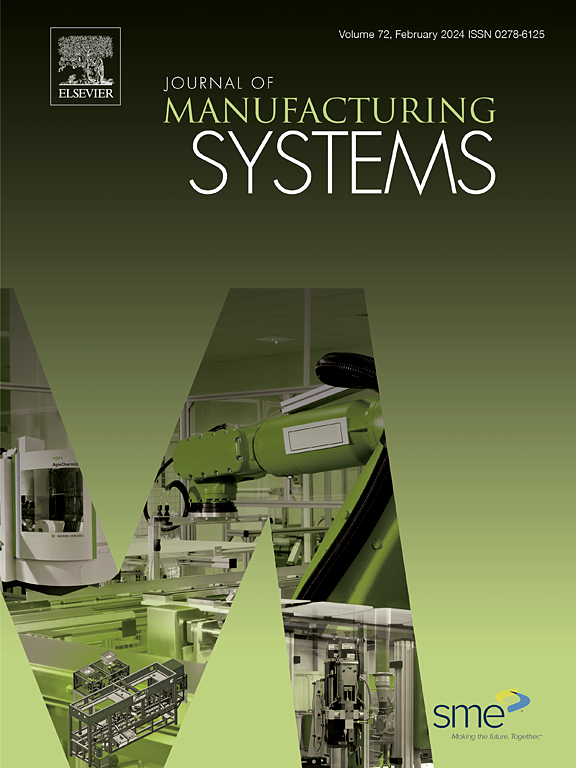A multi-level root cause analysis method for production anomalies in manufacturing workshops
IF 12.2
1区 工程技术
Q1 ENGINEERING, INDUSTRIAL
引用次数: 0
Abstract
Production anomalies, being one of the main causes of disrupted production schedules and product quality issues, have driven the manufacturing industry to focus on real-time monitoring and effective management, as these measures undoubtedly ensure production continuity and enhance efficiency. The complexity of discrete manufacturing workshops—characterized by diverse products, complex process routes, and frequent disturbances—leads to a corresponding complexity in the occurrence and evolution of production anomalies. Unlike point-to-point models for root cause analysis of production anomalies, this paper proposes a multi-level root cause analysis model for production anomalies to reveal the key influencing factors in their evolution process. First, to address the challenge of single-dimensional manufacturing data failing to effectively represent complex production states, production state representation models of manufacturing elements are built based on a first-order graph model of manufacturing elements, enabling consistent expression of production states. Second, a production anomaly evolution pattern analysis model based on a nonlinear Granger model is proposed to answer the questions of how production anomalies arise and evolve. Then, considering the imbalance in production anomalies, a meta-learning Transformer model is designed to learn evolution patterns of production anomalies and enable root cause analysis. Finally, using a real discrete manufacturing workshop as an example, the proposed method can accurately analyze the evolution patterns of production anomalies. In the evolution pattern learning task, it achieves better learning performance and is at least 69.5 % higher than the baseline models on the root mean square error. Additionally, the method achieves an accuracy of 81.67 % in identifying the top three root cause states of production anomalies. The research results demonstrate that nonlinear networks can effectively analyze the complex evolution processes of production anomalies and enhance the Granger model's accuracy in identifying the evolution patterns. The meta-learning framework improves the generalization ability of the evolution pattern learning model, enabling more precise root cause identification. Consequently, the proposed method offers a new perspective for evolution analysis and root cause analysis of production anomalies.
制造车间生产异常的多层次根本原因分析方法
生产异常是生产计划中断和产品质量问题的主要原因之一,因此制造业关注实时监控和有效管理,这些措施无疑可以确保生产的连续性和提高效率。离散制造车间的复杂性——其特点是产品种类繁多、工艺路线复杂、干扰频繁——导致生产异常的发生和演变具有相应的复杂性。与点对点的生产异常根本原因分析模型不同,本文提出了多层次的生产异常根本原因分析模型,揭示了生产异常演化过程中的关键影响因素。首先,针对单维制造数据无法有效表征复杂生产状态的问题,在制造元素一阶图模型的基础上,构建了制造元素的生产状态表征模型,实现了生产状态的一致表达。其次,提出了一种基于非线性Granger模型的生产异常演化模式分析模型,以回答生产异常如何产生和演化的问题。然后,考虑到生产异常的不平衡,设计了一个元学习Transformer模型来学习生产异常的演变模式,并进行根本原因分析。最后,以实际离散制造车间为例,该方法能够准确分析生产异常的演化模式。在进化模式学习任务中,它取得了更好的学习性能,在均方根误差上比基线模型至少高出69.5 %。此外,该方法在识别生产异常的前三个根本原因状态方面的准确率达到81.67 %。研究结果表明,非线性网络可以有效地分析生产异常的复杂演化过程,提高格兰杰模型识别演化模式的准确性。元学习框架提高了进化模式学习模型的泛化能力,能够更精确地识别根本原因。因此,该方法为生产异常的演化分析和根本原因分析提供了新的视角。
本文章由计算机程序翻译,如有差异,请以英文原文为准。
求助全文
约1分钟内获得全文
求助全文
来源期刊

Journal of Manufacturing Systems
工程技术-工程:工业
CiteScore
23.30
自引率
13.20%
发文量
216
审稿时长
25 days
期刊介绍:
The Journal of Manufacturing Systems is dedicated to showcasing cutting-edge fundamental and applied research in manufacturing at the systems level. Encompassing products, equipment, people, information, control, and support functions, manufacturing systems play a pivotal role in the economical and competitive development, production, delivery, and total lifecycle of products, meeting market and societal needs.
With a commitment to publishing archival scholarly literature, the journal strives to advance the state of the art in manufacturing systems and foster innovation in crafting efficient, robust, and sustainable manufacturing systems. The focus extends from equipment-level considerations to the broader scope of the extended enterprise. The Journal welcomes research addressing challenges across various scales, including nano, micro, and macro-scale manufacturing, and spanning diverse sectors such as aerospace, automotive, energy, and medical device manufacturing.
 求助内容:
求助内容: 应助结果提醒方式:
应助结果提醒方式:


